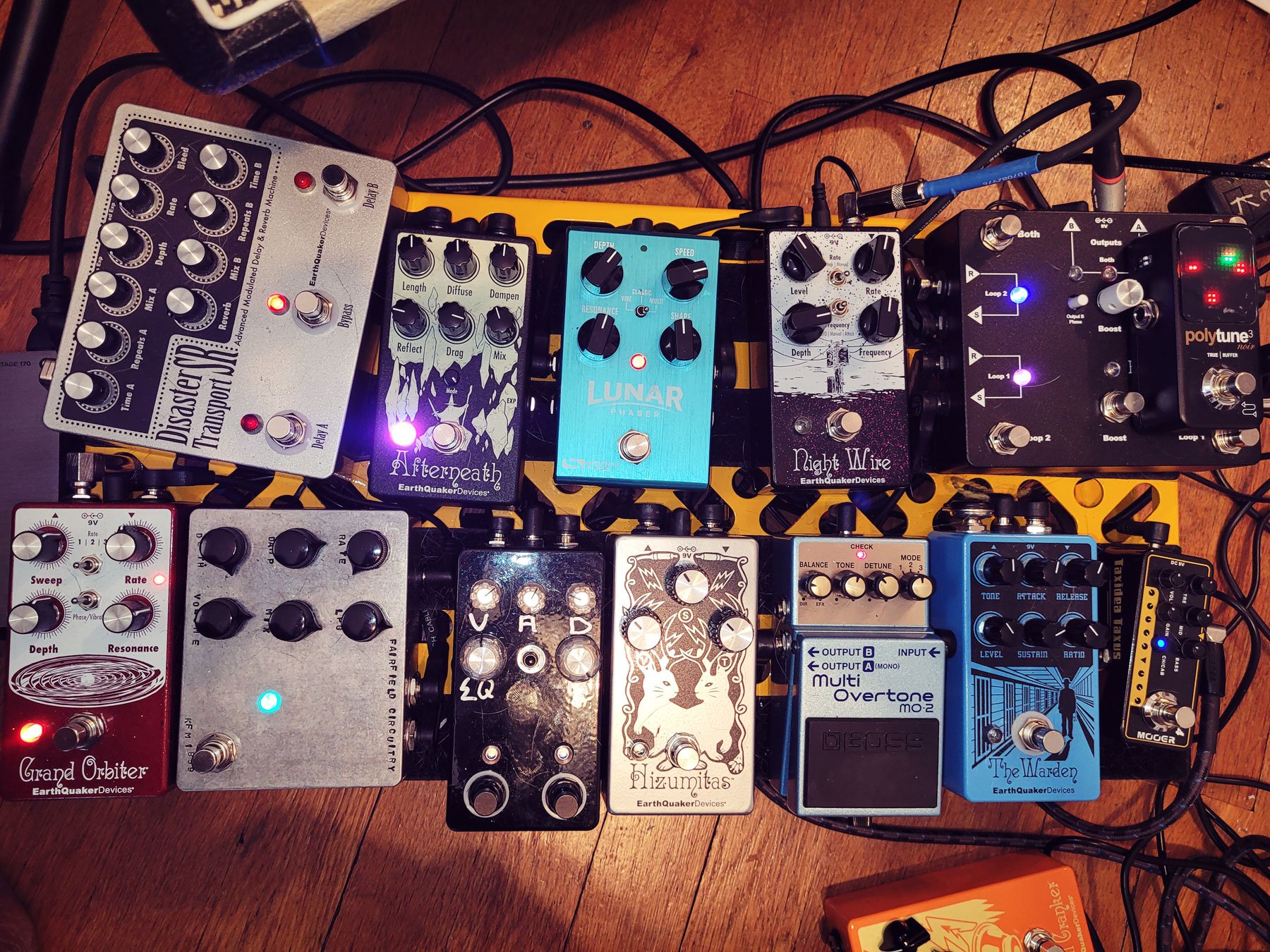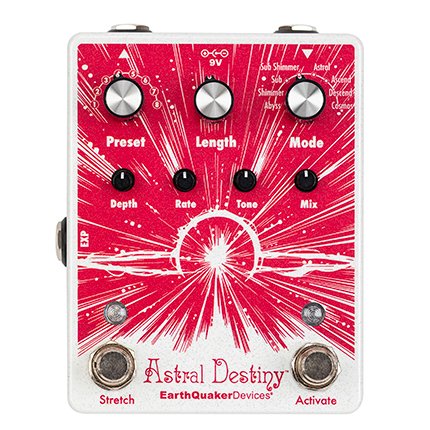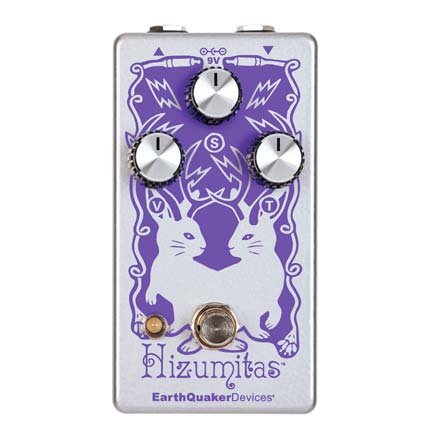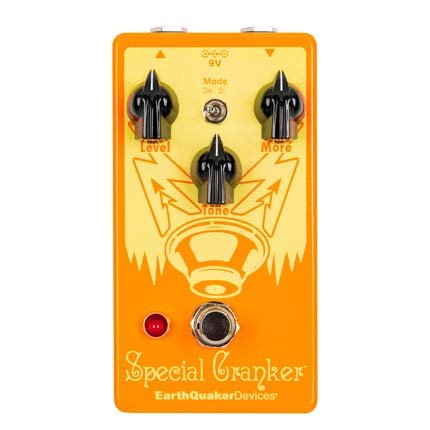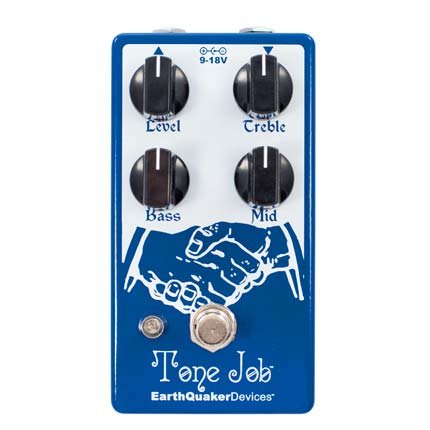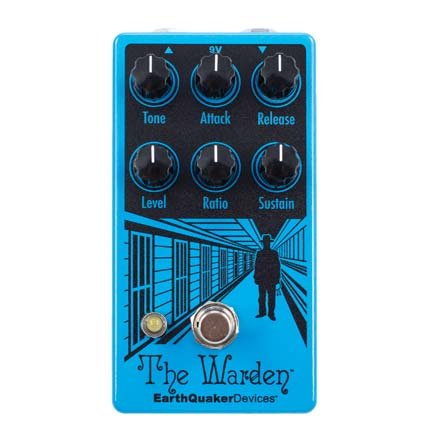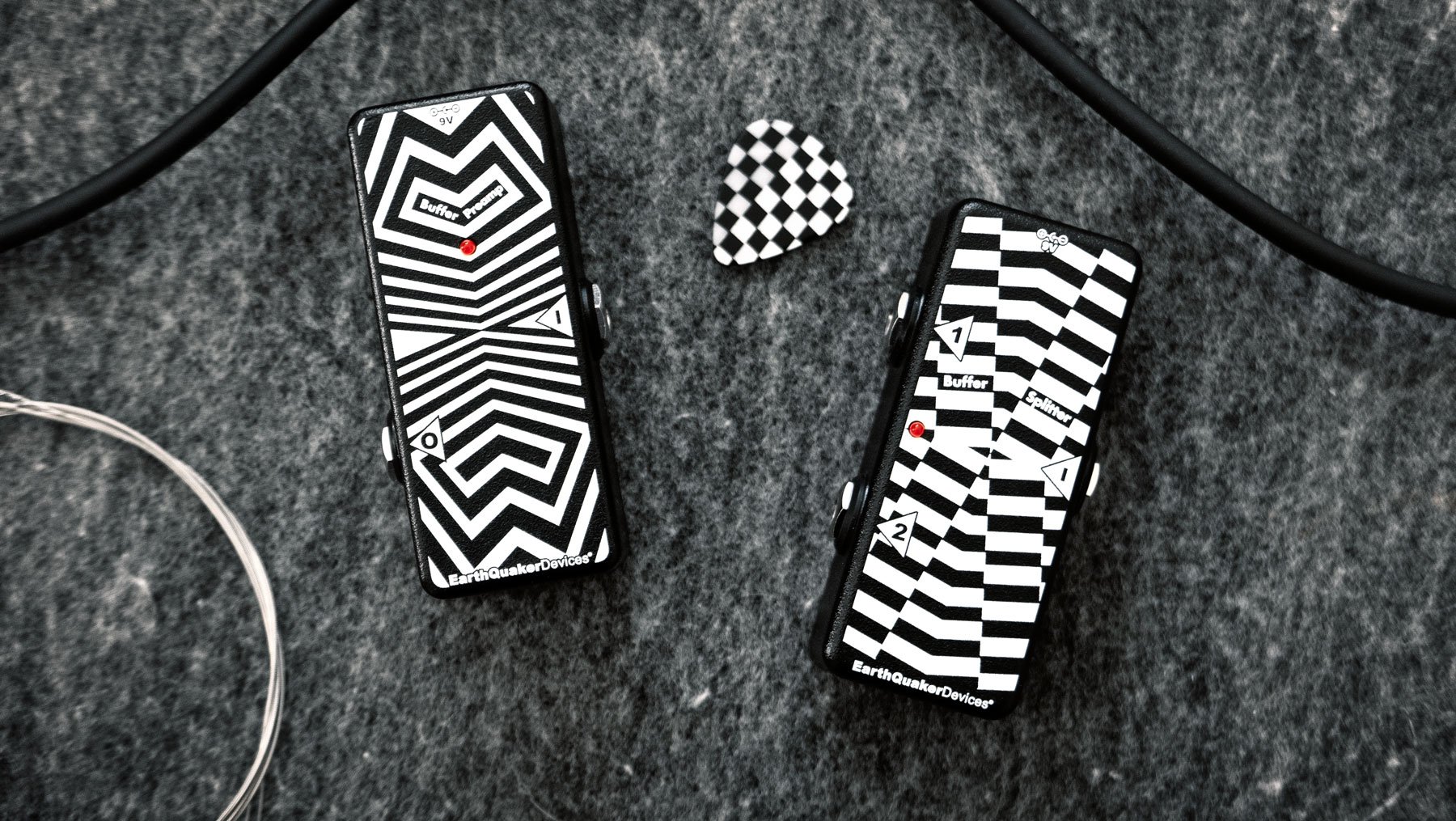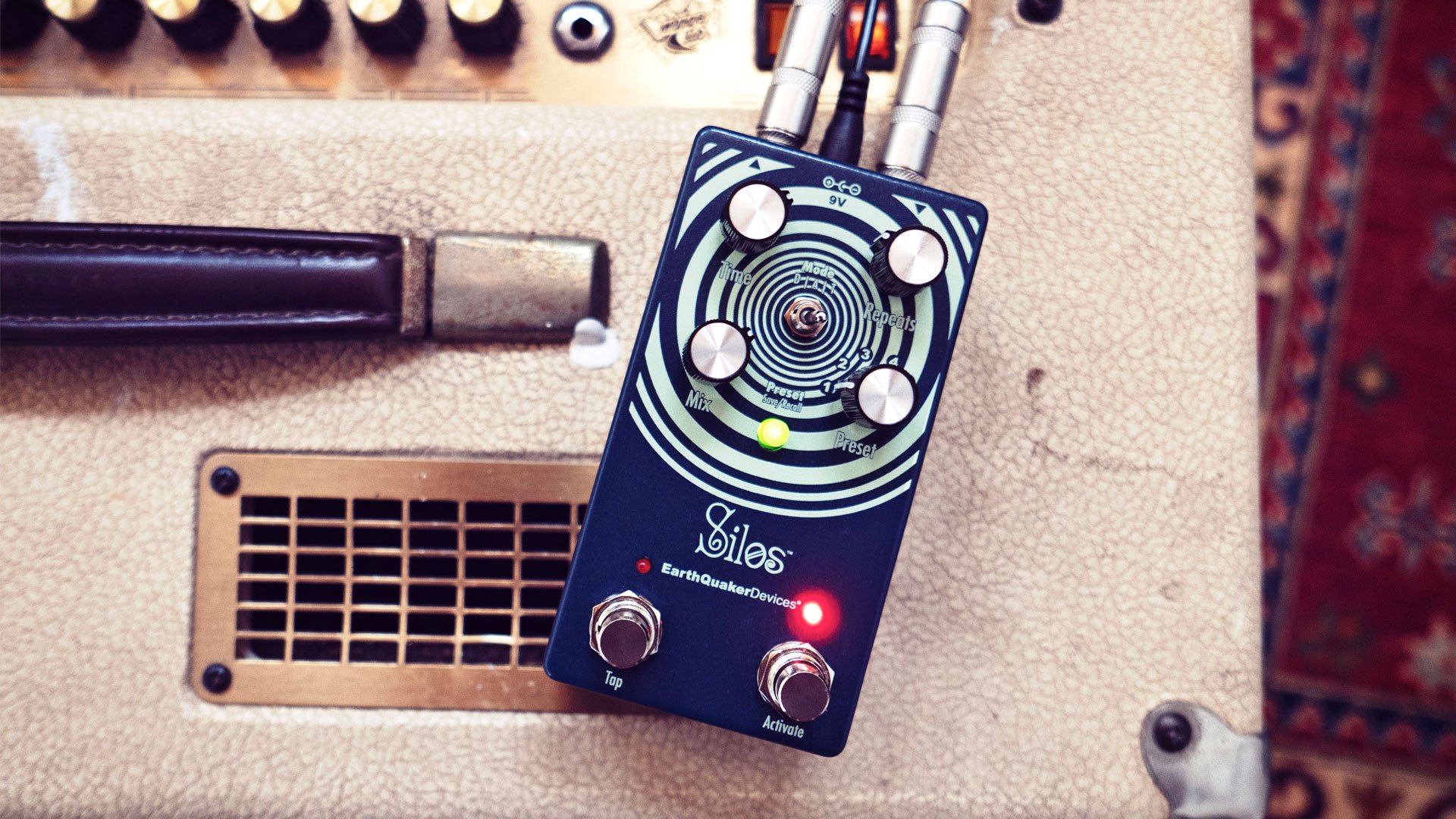Employee Pedalboards
Malcolm X Abram
Here at EarthQuaker Devices, the pedals we make, sell and ship to you, our wonderful fans and customers, are produced by musicians for musicians (and obsessive pedal collectors). But we don't just build, ship, and sell pedals. We also use them for our personal musical endeavors. Not everyone at EQD HQ is gigging, but many of your faithful pedal makers are either in or were in bands or are artists themselves. We love gear too!
And, of course, we love pedals and not just the high-quality stompboxes made here at EQD HQ.
So, to inspire others to branch out and try different configurations and combinations of pedals, we polled a few of our in-house music makers to see what pedals they have on their pedalboards and in their home studios and how they use them. Unsurprisingly, you'll notice many EQD pedals mentioned, but we respect and appreciate the hard work and creativity of all our pedal-producing sistren and brethren. If any of these pedal chain concept are inspiring please also check out the respective links to their music.
Corey Haren
Quality Control Lead
Currently, I have my pedalboard taking the top 4 strings of my guitar into one signal chain and the Bottom 3 strings into another. This split achieves a bass and guitar hybrid sound. The "guitar" side goes into the preliminary signal chain before the Neural DSP Quad Cortex, which consists of the Black Ash, Polytune, Rainbow Machine, and the Thunderclaw.
I use the Black Ash as a lead fuzz setting for when I need a nasty lead sound that I haven't programmed into the Quad Cortex with settings of Fuzz at 4 o'clock, Tone at 1 o'clock, and Level set to 10 o'clock. The Rainbow Machine is set in a classic setting I like to use; Pitch at 12 o'clock tuned slightly up or down depending on the pitch of the chorus sound I want/also the direction of self-oscillation I would like (the signal) to go in. The Tracking is set all the way up (clockwise), and the Tone and Voice knobs are set to taste. I use this setting as a chorus sound and to ramp and divebomb the oscillation effect into various sections of the song I'm playing.
Brian Hill
Production Lead & Process Coordinator
This chain is:
EBS OctaBass - Octave only. FAT AND LOW.
Arrows - 1 o'clock. Makes the Tentacle scream a little more.
Tentacle - On. Yanks the octave'd tone back up and dropkicks it into the sun.
Speaker Cranker - 1 o'clock
Hizumitas - Everything around 10 o'clock
Damnation Audio Loop Blender - Dimed. This LPFs a clean signal from my bass and blends it back in after the FX chain. The clean tone brings articulation to the body and returns those FAT LOWS to the buzzsaw coming out of the Hizu.
Keeley Bassist - It just tames the signal peaks and keeps the lows honkin' evenly across the fretboard.
Tone Job - Perfect for tweaking the EQ of your overall signal to adjust for varying acoustic environments, instruments, amplifiers, or old strings.
Mikey Juba
Production Lead and Printing
So on my board, I have a Warden and an Afterneath.
The Warden is my favorite compressor for fingerpicking. Compressors can often be too poppy sounding on the attack, but on The Warden, you can dial that down, and the Tone knob helps with taming the brightness, so it's not too ear-piercingly twangy.
The Afterneath v3, in my opinion, is the best version of this pedal. I have my mini-expression pedal set up to jump in octaves, and I have the drag and diffuse knobs set for a more traditional reverb sound with less dwell. So, when I switch chords, the reverb has a quicker response to change overtones, so it doesn't get too chaotic or dissonant.
I also use my loop switcher to put various delays or effects before and, uhh, after the Afterneath. You can get trails on your repeats, and if that isn't enough, the Digitech Freqout pedal is exclusively in front of the Afterneath because it sounds awesome. I almost always have them on together. I can play two notes on Wednesday, and I won't hear the second note until Saturday. It's sick.
Ram Youssefi
Shipping Manager
Here's a pic of the board I'm using right now.
It's all about drone: The Warden => Bellows => Life Pedal => Westwood => Dispatch Master => Astral Destiny => Space Spiral => Afterneath => Levitation => Transmisser => Disaster Transport SR => Tone Job
A great combo I like to use is Afterneath into Levitation. My favorite, though, is to turn everything on and drone out. It gets heavy.
Zurvan / Rubber City Noise / Center for Audio/Visual Experimentation (CAVE)
Malcolm Abram
Copy Writer, Artist Rep, Upstairs Bedroom Soundlabs proprietor
I use this combination for a specific song in the band I'm playing with, but it's also great for when you just want to chill and vibe out on your guitar or try out some interesting chord progressions. It's definitely for playing at slower tempos, so you can hear the notes articulate, reverberate, and echo. The Pedal Chain is as follows:
Boss MO-2 Multi Overtones - It's not a particularly popular pedal in the Boss canon. It's on setting two which emphasizes midrange and highs and the "overtones" act as a kind of dual shimmer and octave effect that's picked up nicely by the rest of the chain. I also keep the wet/dry mix mostly dry to keep the overtones in the background.
Fairfield Circuitry Shallow Water - I love this pedal. Here I'm using it as an odd chorus with the (wet/dry) Mix, and Low Pass Gate knobs at around noon to let the overtones from the Boss MO-2 shine through, and the Rate, Damp, and Depth knobs set for a subtle wobble.
Grand Orbiter - For some movement, I'm using a very slow rate, a not very deep a phase sweep, and the Depth, which is the mix of the wet and dry signal, is set around noon, so the phaser complements instead of dominates.
Source Audio Lunar Phaser - Yeah, it's a phaser, but it's also a chorus and a flanger. I'm using it as a flanger to add a bit more movement and because it plays well with the Grand Orbiter when they're both on subtle settings.
Afterneath - This is set for a longer spring reverb sound with slight digital repeats to feed the Delay. The Mode knob is set to octaves, to help tame the repeats and the ambience.
Disaster Transport SR - My favorite EQD delay, I have delay A on with the Time and Repeats knobs at around noon plus a dash of modulation set at a slow rate.
I hope this peak in to some of the musical minds here at EQD HQ proves useful to you next time your staring blankly at your pedalboard, hoping for some inspiration to find new sounds. Don't be afraid to break "the rules," and stay creative!
Malcolm X Abram is a recovering reporter and music writer and a proud 40 year guitar noodler. He lives, works and plays in the bucolic dreamland of Akron, Ohio in an old house with two dogs who don’t really like each other and way too many spiders.





